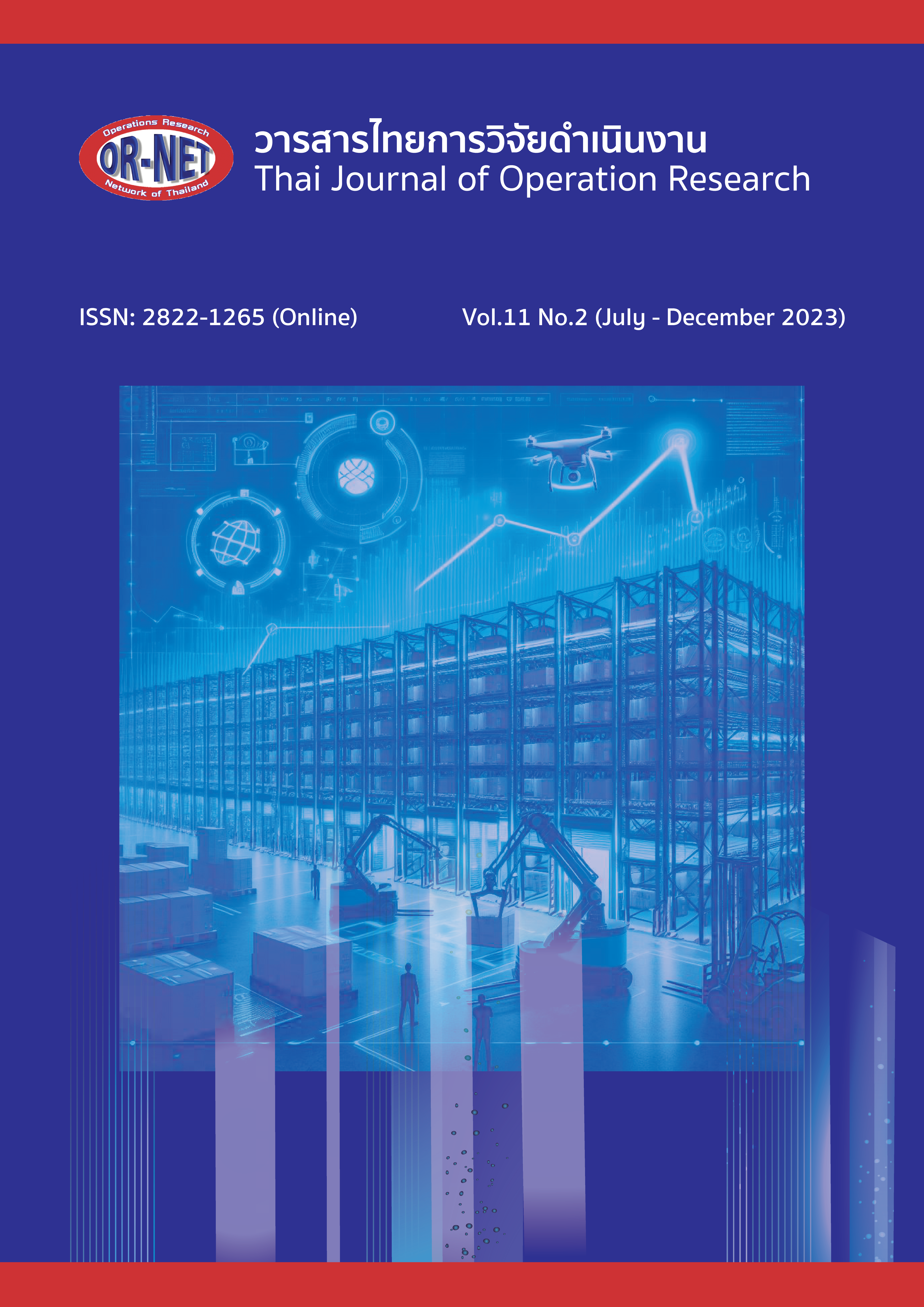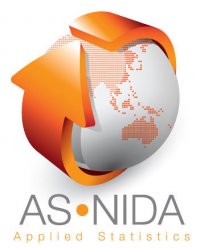Development of Mathematical Model for Humanitarian Logistics Management: A Case Study of Floods Disaster
Keywords:
humanitarian logistics, integer non-linear programming, floods disasterAbstract
This research is development of mathematical model for humanitarian logistics management for a case study of floods disaster in Thailand, using Integer Non-linear Programming (INLP) to determine the location of shelters and the amount of sufficient resources to help the victims. The developed model has been applied to case studies in flood-affected arear, Kantharawichai District, Maha Sarakham Province, which has a total area of 10 sub-districts, 183 villages and has a total of 82,764 victims. There are three villages, of which 570 victims are unable to live in the villages had to be moved to a shelter. The research specifies the scope or major limitations of the problem as follows: 1) there are two relief distribution centers, namely the Maha Sarakham Provincial Disaster Prevention and Mitigation Office and the Kantharawichai District Office, 2) there are 19 alternative shelter centers, which are in various government areas such as schools and temples, and 3) transport of victims and relief items will be used only by trucks. The proposed INLP model was processed with the LINGO 13.0 program. The results showed that two shelters should be opened. The Chumchon Makha School Center is opened for receiving the 164 victims from Kut Hua Chang Village, and the Ban Makok School Center is opened for receiving the 190 victims from Ban Khong Kut Wien, and 216 victims from Ban Huai Chan. For the 180 flood-affected villages, most of them were allocated relief items from Kantharawichai District Office which has a distance closer than from the Maha Sarakham Provincial Disaster Prevention and Mitigation Office. Moreover, both the transportation of the victims and the distribution of relief items should be transported by a 4-wheel operating truck. In addition, the solutions of proposed INLP model also showed that all victims are cover helped, with the minimize total operating cost of 20.859 million THB. Furthermore, the developed model can also be applied to larger scale flood disaster management as a result of the sensitivity analysis, and it can also be further developed for humanitarian logistics management in case of other types of disasters.
References
กรมทรัพยากรธรณี, “แนวทางการการลดความเสี่ยงภัยสึนามิของประเทศไทย,” [ออนไลน์]. แหล่งที่มา: www.dmr.go.th. [วันที่เข้าถึง 1 มีนาคม 2566].
วีรชัย อู๋สมบูรณ์ และ ธารทัศน์ โมกขมรรคกุล, “การศึกษาพัฒนาการด้านโลจิสติกส์เพื่อมนุษยธรรมในประเทศไทย,” จุฬาลงกรณ์มหาวิทยาลัย, 2561.
P. Trunick, “Special report: delivering relief to tsunami victims,” Logistics Today., vol. 46, no. 2, pp. 1-3, 2005.
L. N. V. Wassenhove, “Humanitarian aid logistics: supply chain management in high gear,” Journal of the Operational Research Society., vol. 57, no. 5, pp. 475-489, 2006.
กรมป้องกันและบรรเทาสาธารณภัย, “แนวทางการเตรียมความพร้อมรับมืออุทกภัย,” [ออนไลน์]. แหล่งที่มา: http://122.155.1.141/inner.PRDP M2.53/cms/menu_6284/4119.1/. [วันที่เข้าถึง 1 ธันวาคม 2565].
S. Bhimani and J. S. Song, “Gaps between research and practice in humanitarian logistics,” Journal of Applied Business Economics., vol. 18, no. 1, 2016.
T. Wakolbinger, F. Toyasaki, M. Christopher and P. Tatham, “Impacts of funding systems on humanitarian operations,” in Humanitarian logistics: meeting the challenge of preparing for and responding to disasters, London, Kogan Page, 2011.
คมสัน โสมณวัตร, “ระบบการจัดการโลจิสติกส์เพื่อ ช่วยเหลือผู้ประสบอุทกภัย กรณีศึกษา อำเภอวารินชำราบ จังหวัดอุบลราชธานี,” วารสารวิชาการครุศาสตร์อุตสาหกรรม พระจอมเกล้าพระนครเหนือ., ปีที่ 7,ฉบับที่ 1, น. 164-172, 2559.
S. Gupta, N. Altay and Z. Luo, “Big data in humanitarian supply chain management: a review and further research directions,” Annals of Operations Research., pp. 1-21, 2017.
T. E. Russell, “The humanitarian relief supply chain: analysis of the 2004 South East Asia earthquake and tsunami,” Master's thesis, Massachusetts Institute of Technology, 2005.
B. Render, R. Stair and M. E. Hanna, Quantitative Analysis for Management, Prentice Hall: New Jersey. 2012.
N. Cotes and V. Cantillo, “Including deprivation costs in facility location models for humanitarian relief logistics,” Socio-Economic Planning Sciences., vol. 65, pp. 89-100, 2019.
A. J. Bozorgi-Amiri, M. Saeed and S. M. Al-e-Hashem, “A multi-objective robust stochastic programming model for disaster relief logistics under uncertainty,” OR Spectrum., vol. 35, no. 4, pp. 905-933, 2013.
O. Rodríguez-Espíndola, P. Albores and C. Brewster, “Disaster preparedness in humanitarian logistics: A collaborative approach for resource management in floods,” European Journal of Operational Research., vol. 264, no. 3, pp. 978-993, 2018.
ไพโรจน์ แสนดี, อนันทชัย ชำนาญหมอ และ สุนาริน จันทะ, “การศึกษาเส้นทางเดินรถในการเคลื่อนย้ายผู้ประสบอุทกภัยออกจากพื้นที่อันตราย เมื่อระดดับน้ำสูงกรณีศึกษา: ตำบลลาดสวาย อำเภอล้าลูกกา จังหวัดปทุมธานี,” วารสารวิชาการอุตสาหกรรมศึกษา., ปีที่ 8, ฉบับที่ 1, 2557.
ปุณยภา สุทธิจำนงค์ และ สุนาริน จันทะ, “การจัดเส้นทางเดินรถขนส่งในการอพยพเมื่อเกิดอุทกภัย โดยการพิจารณาประเภทของผู้ประสบภัย,” วารสารวิชาการพระจอมเกล้าพระนครเหนือ., ปีที่ 27, ฉบับที่ 2, 2560.
เกริก วงศ์ลือชา, ฐิติพงศ์ จำรัส, ชุลีพร กุศลคุ้ม และศิโรรัตน์ พัฒนไพโรจน์, “การพัฒนารูปแบบทางคณิตศาสตร์ สำหรับการวางแผนเส้นทางช่วยเหลือผู้ประสบอุทกภัย กรณีศึกษาอุทกภัยในเขตพื้นที่จังหวัดร้อยเอ็ดจากพายุโพดุลและคาจิกิใน ปี พ. ศ. 2562,” วารสารวิจัย มข. (ฉบับบัณฑิตศึกษา)., ปีที่ 22, ฉบับที่ 3, น. 110-126, 2565.
จีระพงศ์ ทองพันธ์, “การพัฒนาอัลกอริทึมการจัด เส้นทางเดินรถขนส่งแบบมีหลายคลังสินค้าที่มีกรอบเวลาไม่แน่นอนสำหรับจัดการภัยพิบัติทางน้ำ,” สาขาวิชาเทคโนโลยีสารสนเทศ, มหาวิทยาลัยศรีปทุม, กรุงเทพมหานคร, 2557.
ธนาภา ควรผดุงศักดิ์ และ สรวิชญ์ เยาวสุวรรณไชย, “การพัฒนาฮิวริสติกส์เพื่อจัดเส้นทางเดินรถขนส่ง สำหรับช่วยเหลือผู้ประสบภัยพิบัติ ณ เวลาที่ข้อมูลมีการเปลี่ยนแปลงไป,” วิศวกรรมสาร มก., ปีที่ 30, ฉบับที่ 99, 2560.
กรมการปกครอง กระทรวงมหาดไทย, “ข้อมูลพื้นที่เสี่ยงสาธารณภัย จังหวัดมหาสารคาม,” [ออนไลน์]. แหล่งที่มา: https://opendata_tst.dopa .go.th/ download.php?cid=3&page=1. [สืบค้นเมื่อ 1 ธันวาคม 2565].
กรมป้องกันและบรรเทาสาธารณภัย กระทรวงมหาดไทย, “แผน ปภ. จ.มหาสารคาม ปรับปรุง 2563,” [ออนไลน์]. แหล่งที่มา: https://www.disaster.go.th/th/download/download/25. [สืบค้นเมื่อ 1 มีนาคม 2566].
บริษัท จิซทิกซ์ จำกัด, “อัตราค่าบริการขนส่ง,” [ออนไลน์]. แหล่งที่มา: https://giztix.com /pricing.
[สืบค้นเมื่อ 18 มีนาคม 2566].
กรมป้องกันและบรรเทาสาธารณภัย กระทรวงมหาดไทย, “คู่มือเครื่องจักรกลสาธารณภัยสำหรับผู้บริหาร,” [ออนไลน์]. แหล่งที่มา: http://measures.disaster.go.th/inner.citeta-1.189 /download/menu_6240/2074.3/. [สืบค้นเมื่อ 1 มีนาคม 2566].
Downloads
Published
How to Cite
Issue
Section
License

This work is licensed under a Creative Commons Attribution-NonCommercial-NoDerivatives 4.0 International License.




